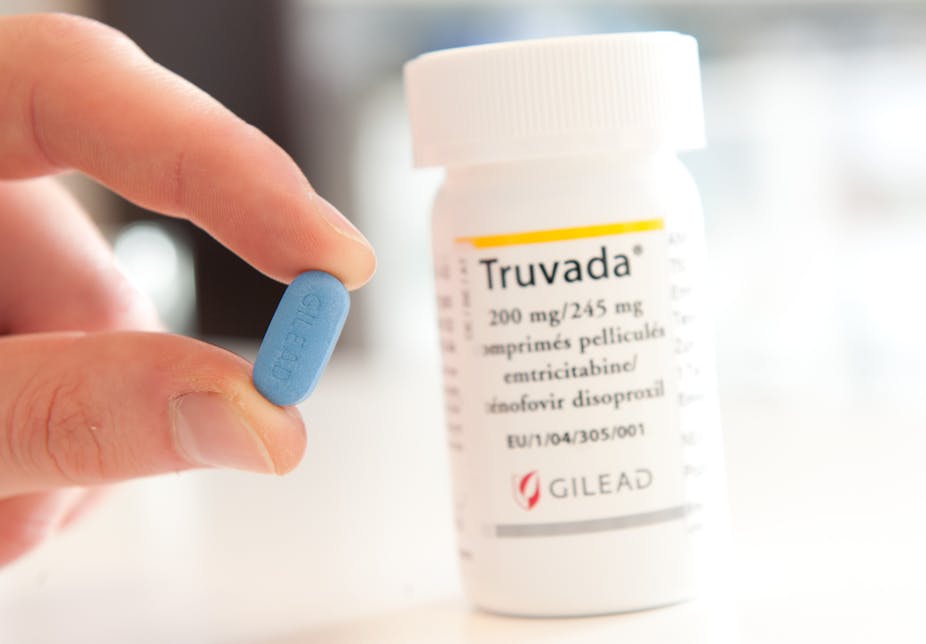The latest report from Public Health England revealed that there were more than 100,000 people living with HIV in the UK, with 6,000 new infections last year. Around a quarter of people are unaware they carry the virus and risk passing it to others. According to the figures, the past year has also seen a rise in the number of men who acquired HIV through sex with other men.
With no cure or vaccine against HIV, these figures clearly highlight the need for new strategies to control transmission. After nearly three decades of anti-viral therapies aimed at treating people after they have been infected, a new preventative measure has been making waves: Truvada.
Truvada has been used in the treatment of HIV for more than a decade, alone or in combination with other anti-viral drugs. But it can also be used as a prophylaxys or PrEP drug – anti-viral that can be taken before exposure to HIV to prime the body against the invader and reduce the risk of infection. It combines two different drugs – tenofovir and emtricitabine – which prevent HIV cells from multiplying.
The original three-year iPrEX study into the efficacy of Truvada in 2010 showed that a daily oral dose of the drug gave 44% additional protection from HIV among the 2,499 men or transgender women who have sex with men (MSM) followed from 2007 to 2007. Overall, this corresponded to a 92% reduction in the risk of acquiring HIV. The study is now being continued on a broader scale to measure the impact of Truvada in the long term.

What is clear from these studies is that the drug alone does not completely prevent HIV-1 infection, nor does it cure the virus. In combination with safer sex practice, however, it can significantly reduce the impact of HIV infection.
Unexpected side effect
Since 2012 the US Food and Drug Administration has approved and licenced Truvada as a preventative measure for HIV. While there is no question that Truvada is efficient in preventing HIV infection and is a great hope for fighting its spread, there have also been some unexpected results with using this kind of treatment.
These centre mainly around sexual behaviour and adherence – particularly that it may actually cause some to give up more traditional prevention strategies like condom use.
Some people may do this, and it may seem plausible that such preventative treatment could encourage unsafe sex practice because participants feel protected – but the original study did consider this. Instead, it found evidence of a decrease in high-risk behaviour within the participants’ cohort. One hypothesis raised by the authors was that the daily ingestion of a pill may act as a reminder of the potential risk, thereby promoting behavioural change towards safer practice.
Strict daily dose
Another key issue here is the strict adherence to the treatment regime – something that has also cropped up in stories about Truvada: that some have taken it as a one-off preventative pill ahead of sex. There is a Canadian trial looking at whether Truvada can be taken on an intermittent basis but there is currently little information about the efficacy of Truvada in those who fail to follow this daily requirement.
The iPrEX study relied on participants swallowing the pills every day. Clearly, if the pill is taken occasionally ahead of unprotected sex then it is likely to only be very moderately efficient. The study showed that participants who engaged with daily administration only 50% of the time, had a 50% reduction in the efficacy of protection.
While Truvada is part of post-infection treatment regimen in the UK, it is not currently used as a preventative treatment. To deepen our understanding of these issues in the UK, the Medical Research Council is sponsoring a study to investigate the effect of prophylaxis treatment in the population of men who have sex with men, but also the potential changes in sexual behaviour and adherence to the treatment.
Adverse effects
Several factors commonly associated with most HIV antiviral therapies also have to be taken into account. A common side effect reported is frequent nausea over several weeks. More adverse effects such as production of lactic acid in the blood and liver problems have also been reported. Patients with hepatitis B infection can also encounter worsening of their symptoms. We also know very little about the emergence of resistance against Truvada which might impair its wider use in the population.
In addition to all of this is the question of cost. The cost of the pill in the US is estimated to range from US$8,000 to US$12,000 per year, which corresponds to a continuous daily supply. NICE puts the price for the drug at £418.50 per 30-tablet pack, which means if used as a PrEP treatment it could cost up to £5,092 per year.
To have an impact, this treatment need to go further than just giving a drug to a small fraction of the population, otherwise it is unlikely to have a broader impact on transmission. So it may block the spread of HIV in groups like men who have sex with men, but there would be no effect on transmission in the heterosexual population, lessening its overall impact. But could more blanket cover prove too expensive?
Despite a reduction in the number of late diagnoses of HIV, which has led to better more efficient treatment earlier on, there is little evidence that HIV transmission is diminishing in the MSM population. Drugs such as Truvada and other PrEP drugs could prove a game changer in our approach to HIV, but given the cost and the reports about adherence the new study into these issues in the UK is to be welcomed.

